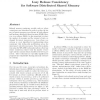283 search results - page 15 / 57 » Effective Program Verification for Relaxed Memory Models |
211
click to vote
POPL
2009
ACM
16 years 9 days ago
2009
ACM
Speed improvements in today's processors have largely been delivered in the form of multiple cores, increasing the importance of ions that ease parallel programming. Software...
106
Voted
DC
2010
14 years 11 months ago
2010
Model checking software transactional memories (STMs) is difficult because of the unbounded number, length, and delay of concurrent transactions and the unbounded size of the memo...
107
Voted
ISCA
2006
IEEE
14 years 11 months ago
2006
IEEE
Conventional relaxed memory ordering techniques follow a proactive model: at a synchronization point, a processor makes its own updates to memory available to other processors by ...
107
Voted
ISCA
1992
IEEE
15 years 3 months ago
1992
IEEE
Relaxed memory consistency models, such as release consistency, were introduced in order to reduce the impact of remote memory access latency in both software and hardware distrib...
TPHOL
2009
IEEE
15 years 6 months ago
2009
IEEE
Abstract. Real multiprocessors do not provide the sequentially consistent memory that is assumed by most work on semantics and verification. Instead, they have relaxed memory mode...

